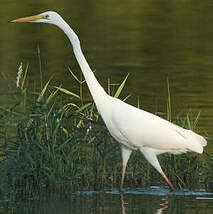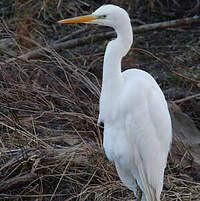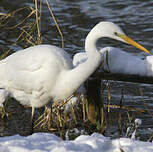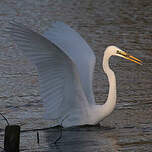Great Egret
Ardea alba - Grande Aigrette
Identification
The Great Egret is a large cosmopolitan white heron, one of the largest in size. It is more slender and less bulky than the Grey Heron, which it surpasses in length. Its very long neck forms a characteristic S shape at rest, with a break in the middle. Its plumage is entirely white, which, combined with its large size, makes it unmistakable, if not with the rare leucous forms of other large herons such as the Great American Egret. No dark morphs are known for it. The inter-nuptial white plumage is as sober as it can be. The beak is long and not very high, and is then yellow to orange-yellow and the legs are black. At the approach of reproduction, long ornamental feathers called aigrettes appear on the back, lower neck and chest, which will serve as seduction elements during the nuptial parade, but no elongated feathers at the back of the head in this species. The bare parts of the body are colored. In the nominal subspecies to which we are accustomed, the beak darkens, the lores turn green and the tibias redden. It is different in the other subspecies, but one will always recognize a Great Egret by the length of the lower bill which clearly extends beyond the eye towards the back, which is generally well seen in photos.
Subspecific information 4 subspecies
- Ardea alba alba (c Europe to ne Asia south to n and c Africa and s Asia)
- Ardea alba melanorhynchos (Africa south of the Sahara)
- Ardea alba modesta (s, e Asia to Indonesia and Australasia.)
- Ardea alba egretta (s Canada to s Argentina and s Chile)
Foreign names
- Grande Aigrette,
- Garceta grande,
- garça-branca-grande,
- Silberreiher,
- nagy kócsag,
- Grote Zilverreiger,
- Airone bianco maggiore,
- ägretthäger,
- Egretthegre,
- beluša veľká,
- volavka bílá,
- Sølvhejre,
- jalohaikara,
- Grootwitreier,
- agró blanc,
- Mjallhegri,
- czapla biała,
- lielais baltais gārnis,
- velika bela čaplja,
- Большая белая цапля,
- Kuntul besar,
- ダイサギ,
- 大白鹭,
- นกยางโทนใหญ่,
- 大白鷺,
Voice song and call
When disturbed, the Great Egret emits a loud, raspy kraaaah sound. On its breeding grounds, the vocabulary diversifies during the parading within the couple or in interactions between individuals within the breeding colony. But these are always raspy and deep vocalisations.
Habitat
The Great Egret occupies a very wide variety of wetland areas, both coastal and inland, and even locally terrestrial habitats. It feeds or hunts on a great diversity of aquatic and terrestrial invertebrates and vertebrates. Its habitat typically includes woody areas used as resting places. It nests in reed beds or shrubs above or on the edge of water.
Behaviour character trait
The Great Egret is a social bird that is most often observed in groups regardless of the season. Of course, it is mainly the availability of food that concentrates these birds in favourable places, but not only.
They also like the company, even if in winter for example there are aggressive behaviours in defence of restricted fishing sites. Reproduction is colonial, and territoriality is exercised exclusively in the immediate vicinity of the nest. The Great Egret is diurnal. At night, they gather in large numbers in arboreal communal dormitories located in areas that are little or not disturbed. They can come from very far away, several tens of kilometres, knowing that they will be protected there. It predates by taking slow steps in fairly deep water or on dry land, depending on the prey being sought. It can remain motionless, if necessary for long periods of time. It knows how to use its foot to stir up the water and thus flush out its prey, like many other birds of different groups. The prey is harpooned with its beak, which proves to be a very effective weapon due to the bird's rapid neck movements. On land, it is the field mice and small mammals that are thus stabbed. During reproduction, the nuptial parade sees the adult reproductors displaying their magnificent ornamental feathers, spread out like large fans. This is accompanied by mimicry and vocalizations that occur only at this moment in their annual cycle.Flight
The long and wide wings of the Great Egret give it a majestic flight because of its ample and slow flapping, more supple than the Grey Heron's. The flight is direct and sustained, with regular flapping; gliding is only used when approaching the destination, as it glides towards the ground.
Dietfeeding habits
The Great Egret is not just a consumer of fish. Its predation is exercised on a wide variety of vertebrate and invertebrate prey, both aquatic and terrestrial, although small fish always comprise the predominant part of its diet. It is quite typical to see it in the meadows or fields in the non-breeding season looking for voles, like the Grey Heron can do.
Reproduction nesting
The nesting habits vary a lot based on the subspecies and local conditions. The Great Egret can nest alone, but most of the time it nests in colonies along with other ardeids or even other families (ibises, spoonbills, cormorants, etc.
The nominate subspecies typically nests in reed beds, just like the Purple Heron, but also in low-lying woody vegetation above the water (like a riparian shrubland). Elsewhere, nests can be built up to 15 meters high, rarely higher. The nest is a loose platform made of twigs and branches, usually about a meter in diameter and roughly 20 cm in thickness. It is not typically lined at all. As they nest, the adults add materials to the periphery until the young can fly. The same nest might be reused the following year, if it survived the weather. The female lays 4-5 eggs that are smooth and blue-green or pale blue. Incubation lasts 23-24 days, led by both adults. The chicks are semi-precocial and take trips outside of the nest when they are around 15 days old. Both parents feed them by regurgitation directly into their throats. At 35-40 days old, they first begin to make short flights.Geographic range
The Great Egret is a cosmopolitan species, absent only from the Antarctic continent. Its range is therefore very wide and the species is divided into several different subspecies: alba in the western Eurasian continent, modesta in the east of the same continent and in Oceania, egretta in the Americas and melanorhynchos in Africa. The most northerly populations are migratory and migrate to the large wetland areas of the southern temperate region, the Mediterranean region and the tropics during the boreal winter. For the past 40 years, it has been steadily increasing in the inter-breeding season in Western Europe, a sign of an increase in population and/or a change in migratory patterns. Recently, it has even settled down as a niche. Thus in France in La Grande Briere.
Threats - protection
IUCN conservation status
concern
in the Wild
threatened
evaluated
The Great Egret is not currently threatened. It suffered in the 19th and early 20th centuries from the plumage industry which coveted its ornamental feathers to trim the hats and clothing of high society ladies. It is now officially protected by law in many countries, although poaching is probably still a problem in some areas such as Africa, chronically lacking in animal proteins. But this does not put the species at risk. More of a problem is the degradation of wetlands, which leads to a loss of habitat. This was the case for example in Iraq during Saddam Hussein's large-scale draining of the Mesopotamian marshes, the effects of which were major and led to a reorganization of the species's reproduction and, above all, wintering areas. Efforts are currently being made to restore these essential wetlands. The development of human activities at the edge of the water, areas always much sought after, can also have a very negative impact.
Sources of information
- IOC World Bird List (v14.2), Gill, F and D Donsker (Eds). 2024-04-18.
Other sources of interest
 Specification sheet created on
18/07/2023 by Jean François
Specification sheet created on
18/07/2023 by Jean FrançoisTranslation by AI Oiseaux.net
© 1996-2025 Oiseaux.net
- Accipitriformes
- Aegotheliformes
- Anseriformes
- Apodiformes
- Apterygiformes
- Bucerotiformes
- Caprimulgiformes
- Cariamiformes
- Casuariiformes
- Charadriiformes
- Ciconiiformes
- Coliiformes
- Columbiformes
- Coraciiformes
- Cuculiformes
- Eurypygiformes
- Falconiformes
- Galliformes
- Gaviiformes
- Gruiformes
- Leptosomiformes
- Mesitornithiformes
- Musophagiformes
- Nyctibiiformes
- Opisthocomiformes
- Otidiformes
- Passeriformes
- Pelecaniformes
- Phaethontiformes
- Phoenicopteriformes
- Piciformes
- Podargiformes
- Podicipediformes
- Procellariiformes
- Psittaciformes
- Pterocliformes
- Rheiformes
- Sphenisciformes
- Steatornithiformes
- Strigiformes
- Struthioniformes
- Suliformes
- Tinamiformes
- Trogoniformes

































